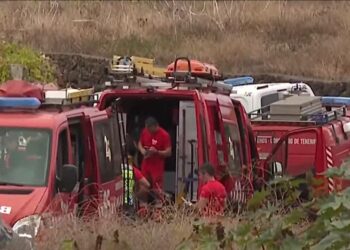The municipality’s Mixed Water Company (Emmasa), in conjunction with the capital’s City Council, will bring forward the deadline for completing the channeling works that will deliver desalinated water to the Southwest district by six months. Initially scheduled for completion in August 2025, the project will be expedited so that by the end of January, the 52,000 residents of this area will benefit from water sourced from the desalination plant. This initiative aims to ensure a stable supply and also resolve the current water consumption issues affecting 19,000 inhabitants of La Gallega, El Sobradillo, and Llano del Moro caused by elevated fluoride levels identified in analyses.
The mayor, José Manuel Bermúdez (CC), mentioned yesterday that the council is implementing an action protocol to safeguard those impacted by the temporary water consumption restrictions due to the high fluoride concentrations in the supply from the northern part of the island, which arrives via the Los Dornajos-Baldíos transfer channel. “We will continue conducting assessments to evaluate the quality of the water provided and introduce measures to enhance the situation in the area. Thus, the emergency works already initiated to supply desalinated water represent the swiftest and most effective resolution.”
Councillor for Public Services, Carlos Tarife (PP), highlighted that the fluoride levels recorded from the analyses by the General Directorate of Public Health of the Government of the Canary Islands range from 1.7 to 2.1 milligrams per litre, exceeding the recommended 1.5 mg/l. “The answer lies in accelerating the Ofra-El Chorrillo supply channeling project, which will facilitate the transport of water generated by the desalination plant to the Southwest, thereby eliminating the dependence on water from the Los Dornajos-Baldíos canal, which has been adversely affected by the 2023 fire and the ongoing water crisis.”
Tarife further stated that “a segment of the work has already been concluded, and current operations are underway in the Las Moraditas area and at the roundabout of the Nuestra Señora de Candelaria University Hospital. Here, the pipes that will convey the desalinated water to the Southwest will connect, thus reducing reliance on the northern canals that are impacted by fluoride, which hinder water consumption for children under 8 years of age.”
Upon completion of the works, desalinated water will flow into the district from Los Alisios and Barranco Grande, alongside the Araya canal, “which will eliminate the existing consumption restrictions,” stated the mayor. He further explained, “We are also advancing on the project to expand the Santa Cruz desalination plant, increasing its capacity from 30,000 to 48,000 cubic metres of water production per day. For this, it is essential that we collaborate with the Island Council of Aguas, Cabildo de Tenerife, and the Government of the Canary Islands to secure project funding.”
In the meantime, the councillor for the Southwest, Javier Rivero, reminded that “a new water distribution point has been established in Llano del Moro, joining the other two positioned outside the La Jurada water tanks (El Bicácaro street) and El Sobradillo (Baile del Vivo Street).”
















